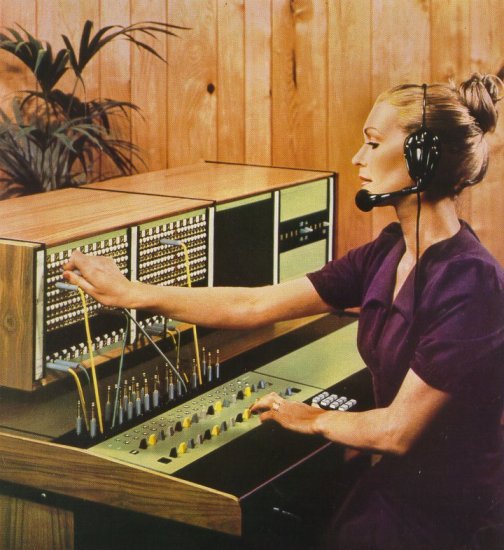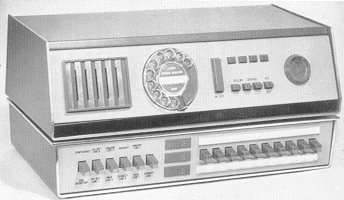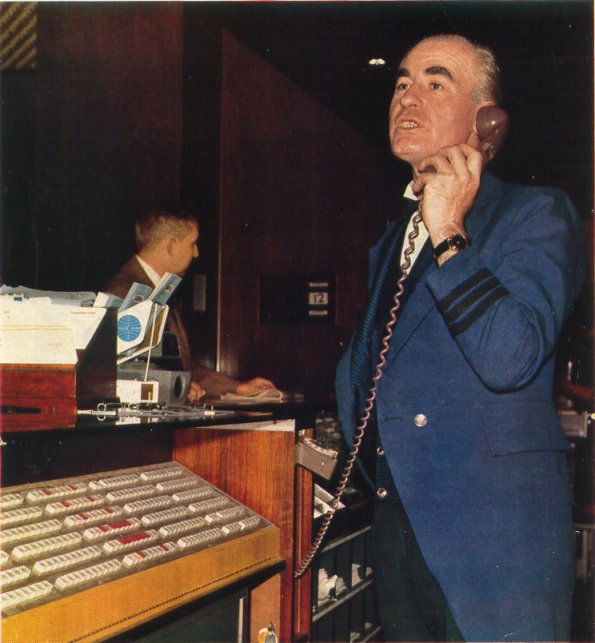|
G.E.C. Series 3 Private Telephone System
-
 GEC 'Series 3' provides an efficient and flexible
telephone service to meet the communication needs of any organisation -
wherever people, or computers,
need to talk to each other. GEC 'Series 3' provides an efficient and flexible
telephone service to meet the communication needs of any organisation -
wherever people, or computers,
need to talk to each other.
- GEC 'Series 3' can be installed as a PABX, PAX or
PMBX-automatic operation to meet the needs of modern business, or manual
operation to provide the personal
service of a luxury hotel, or a combination of both.
- GEC 'Series 3' is built up from a series of
standardised equipment racks, low-line operator's switchboards, and high
performance GEC telephones. By suitable combination, almost any form of
telephone system can be evolved.
- GEC 'Series 3' is both extensible and convertible.
A small system can be installed initially and equipment added to match
communication growth.
- GEC 'Series 3' can be converted at any time to meet
changing requirements without having to replace existing equipment and with
out recourse to custom-built inflexible units. The accompanying diagram illustrates this.
- GEC 'Series 3' is suitable for systems ranging from 100
extensions upwards. There is no
upper limit except in PMBX form which has a practical limit of 800. For
systems requiring less than 100 extensions which are not expected to reach
this level in, say, 5 years one of the smaller GEC cabinet type PAX or PABX
systems may be more suitable.
|
The Basic Versions
|
Inter-Extension Calls
|
Public-Exchange Calls
|
| PAX |
Private Automatic Exchange |
Automatic dialling |
None |
| PMBX |
Private
Manual Branch Exchange |
Via the switchboard operator |
Via
the switchboard operator |
| PABX |
Private
Automatic Branch Exchange |
Automatic dialling operator or automatic dialling |
Via the switchboard |
Low-line
switchboard
The switchboard is attractively styled in teak with
green and black working surfaces. Its
low height - only 1065 mm (3 ft 6 in) - is ideal for areas where the operator
is also the receptionist. Typically,
four switchboards would need a floor area of about 3 m x 4 m (10 ft x 13 ft).

Each switchboard section has space for 200 extension
lines: as the system expands, sections are added but if the system will never
exceed 300 lines, these can be accommodated on a single switchboard. The operator answers and extends a call by a 'cord circuit' and can
handle up to 15 calls at a time. A
pushbutton keysender is fitted.
In systems of up to 800 lines, each extension is
identified on the switchboard with individual 'line lamps'; on larger systems,
calling extensions are signalled on grouped calling lamps. The practical maximum for a PMBX system is 800 lines.
Free-line signalling is employed in the exchange-line
and interswitchboard line circuits thus saving valuable time in obtaining a
free line.
An adaptation of the standard switchboard, approved by
the Royal National Institute for the Blind, is available for blind operators.
Both blind and sighted operators can staff these switchboards.

Switching
equipment
Switching equipment is mounted on steel frames 2286 mm
(7 ft 6 in) high. A separate room
is required with a ceiling height of 2.7 m (9 ft). A 300-line PABX system could be housed in a room 3.5 m x 5 m
(12 ft x 17 ft).
Telephones
GEC746 desk telephones, GEC741 wall telephones, and
'Keyphone' pushbutton telephones are available in a wide colour range. GEC Loudspeaking telephones enable an executive to carry on a telephone
conversation whilst having both hands free. GEC switching telephone systems enable a secretary to receive an
executive's calls and to transfer only those that require his personal
attention.
GENERAL
FEATURES
Internal calls between staff are fully automatic or (on
a PMBX) via the operator.
Incoming calls are controlled by the operator.
Trunk offering
The operator can break into any
conversation and offer a waiting public-exchange call.
Outgoing calls
Extensions can either make all calls
through the operator or may be allowed to dial their own public-exchange
calls.
Trunk call restriction
When direct dialling out is
allowed, selected extensions can be automatically restricted to local calls
only; trunk calls being made through the operator.
Metering
Extensions with direct-dialling out may be
metered at the exchange. All
calls via the operator can be metered at the switchboard.
Enquiry
During a public-exchange call, an extension can
ring another extension or the operator to make an enquiry without being
disconnected from, or overheard on, the public-exchange line. Transfer of a call to another extension is normally made via the
operator.
Tie lines
Where there are two or more private exchanges
within an organisation, they can be interconnected by tie lines independent of
the public exchange. Such calls
can be made automatically or via the operator.
ADDITIONAL
FEATURES
The following paragraphs describe some of the more
usual extra facilities that can be added to the 'Series3' system. There are many others, and experienced engineers are available to help
solve the particular communication problems of any organisation.
Executive's priority
Selected extensions can secure immediate connection,
interrupting any telephone that may be engaged.
 Direct-access Direct-access
Keycalling enables executives to 'key' up to 20
selected extensions without dialling. An LST4D voice switched loudspeaking
telephone with an added direct -access key calling unit is shown to the
right.
Message waiting
Messages left for absent staff can be passed on with
minimum delay upon their return. An
illuminated 'message waiting' panel, under the control of the receptionist
and/or operator, is also coupled to a light on each telephone. Staff returning to their offices, or passing through Reception, can see
the message-waiting lamp and know, if it is lit, that a message has been left
for them.
Absent extension transfer
A member of staff can press an 'absent' button on his
telephone and calls will be automatically transferred to another predetermined
extension. Alternatively, this
transfer can be made automatically after a delay of, say, 30 seconds.
Free-extension search (group hunting)
The switching equipment can be arranged c that should
one telephone (in a large office, for example) be engaged, further calls are automatically routed to the
nearest 'free' telephone.
Conference
Up to l0 extensions can be connected together via a
special circuit for a conference by telephone. On PABX systems, an exchange line can be included, but with a maximum
of five extensions.
Staff location
A special 'locating' number, followed by a personal
code is dialled from any extension or by the operator to initiate a visible or
audible calling system. The
person called responds by dialling a special 'answering' number from the nearest telephone, connecting him
directly to the caller.
Radio paging
An alternative staff-location service uses a
radio-paging system under the control of the operator.
Public address
A public address system under the control of the
operator can be provided.
Central dictation
By dialling a specified number, the switching equipment
will automatically select the first available machine of a group of dictation
machines. On PMBX systems, the
connection is made via the operator.
Data transmission
Any data terminal suitable for operation over normal
telephone lines can be used with the exchange to provide data transmission at
speeds of up to 1200 baud. GEC
data modems are available.
Emergency
In an emergency, staff can dial an easily-remembered
number (for example 666) which activates alarm lights and bells at the
switchboard to command the urgent attention of the operator. The emergency line can accept simultaneous calls so that the line is
always available for reporting emergencies.
Night service
At night, exchange lines can be connected direct to
selected extensions so that they make and receive calls to and from the public
exchange when the switchboard is unstaffed. Alternatively, an incoming call (signalled by bells at strategic
points) can be answered at any telephone by dialling '8'.
Security patrol record
Security staff can dial a designated number from any
telephone, and exchange equipment prints out time and calling number.
'Single digit' services
In addition to the normal 'single digit' features (dial
'0' for the operator, etc.) certain specialised operational services - such as
the Surgery - may be reached by dialling a single digit instead of the normal 3 or 4 digit number.
An 'area service' dialling system can be provided.
By dialling a single digit the call is automatically routed to the
nearest representative of the desired service; for example, dialling a common
digit for 'maid service' in a hotel, regardless of the floor, will connect the guest to the
appropriate floor maid.
Enquiry and transfer
In addition to the standard enquiry facility, provision
can be made for the automatic transfer of public-exchange calls to other
extensions.
Fire
alarm
A further easily-remembered 'non-busy' number can be
provided for fire-alarm services. In
addition, zone indicators defining the location of a fire can be provided.
1972 and 1975 GEC Telecommunications Limited
GEC HOTEL TELEPHONE SYSTEMS

Personal Service- the hallmark of the Good Hotel
 In
the age of automation and computer-controlled systems GEC have designed and
supplied PABX automatic telephone systems to suit the age. Direct dialling in to
extensions and dialling out with automatic metering - all accelerate the speed
of communication. The PABX operator with her modern cordless board with
pushbutton operation and television-like screen is still essential but to a
lesser degree. In
the age of automation and computer-controlled systems GEC have designed and
supplied PABX automatic telephone systems to suit the age. Direct dialling in to
extensions and dialling out with automatic metering - all accelerate the speed
of communication. The PABX operator with her modern cordless board with
pushbutton operation and television-like screen is still essential but to a
lesser degree.
These automated systems are vital to meet the needs of the modern business world
where the tempo of industry and commerce insists on the speed of automatic
connexion at the expense of old world charm - but would you, a hotelier, change
your first-class restaurant into an automated self-service cafeteria? Of course
not, because personal service is still of paramount importance to the good hotel
with a reputation to keep - or make. It's the same with the hotel telephone
service. The modern cordless switchboard cannot economically match the
traditional cord-type switchboard in providing all the facilities that enable
the well-trained operator to use her charm and courtesy, her friendliness and
eagerness to help - this is personal service.
GEC with a history stretching back to the very beginning of the telephone
service, has always recognized the superiority of the cord switchboard for hotel
systems. Recently it recognized that the upright design of switchboard,
basically unchanged for many years, was not an attractive shape to install in
the spacious open-plan reception areas often provided in new hotels. So a
new low-line cord-type switchboard has been introduced for the PABX No. 3
telephone system. The modern teak-finished cabinet is a console that any
architect or hotelier will be proud to incorporate into the reception area to
emphasize the efficiency, and the personal aspect of the hotel's service.
The Pegasus Hotel, Guyana, the Sheraton-Malta Hotel, the Cavendish Hotel, London
and the Intercontinental Hotel, Lusaka, Zambia, are four of the many luxury
hotels, recently built that are using GEC Hotel Telephone Systems to
provide PERSONAL SERVICE.
Your Telephone System
GEC design telephone systems with built-in flexibility to meet the
specialized and exacting demands of any size or type of hotel. Systems can be
custom-built to suit your individual communication needs.
The new PABX 3 is ideal for hotels requiring more than 50 extensions - the
capacity of the exchange is unlimited. It has been designed to provide the
ultimate in personal service for that very important group of people - your
guests. A hotel builds its reputation on service. The GEC PABX 3 is built to
provide that service.
Your Guests
All your guests requirements can be obtained by asking the operator. In
systems with up to 800 extensions each room is individually identified on the
switchboard so that your operator knows immediately who is making the request
and doesn't need to ask. This is not possible with a cordless-type switchboard
without costly additional equipment.
Alternatively, the following automatic facilities are available:-
Guest to Guest
Guests may call each other by dialling the appropriate number. However, many
hotels prefer that these calls are controlled by the operator.
Hotel Services
Guests may call room service, reception, housekeeper and other hotel services by
dialling a single ", digit. Dials incorporating symbols denoting the service may
be supplied. When services are closed, calls may be automatically transferred to
the operator.
Emergency
In an emergency guests can dial an easily remembered number, for example '666',
which activates alarm lights and bells at the switchboard to command the urgent
attention of the operator.
Outgoing calls
Guests can either ask the operator or may be allowed to dial their own local and
trunk calls.
Trunk Call Restriction
When direct-dialling out is allowed this facility can be automatically
restricted to local calls only; trunk calls being made through the operator.
Metering
All outgoing calls may be automatically recorded by individual metering
equipment in the exchange and displayed on a meter panel at the reception desk
so that the total telephone charges for each room are always available for
preparation of guests' accounts.
Incoming calls
All incoming calls are controlled by the operator.
Operator-assistance
During an outside call guests can call the operator, for advice or information,
by pressing a pushbutton on the telephone.
 Message
waiting Message
waiting
When guests have been out of the hotel and messages have been left for them a
message-waiting facility will help your staff to pass on the message with a
minimum of delay - another aspect of personal service.
A message-waiting panel (shown to the right) may be provided at the reception
desk which shows all the room numbers. When a message has been left, the
telephone operator, or the receptionist, can 'light-up' the appropriate room
number so that when the guest returns the staff can see at a glance that there
is a message for that guest. Small lamps on each bedroom telephone are coupled
with the 'message-waiting' panel and light simultaneously so that guests
returning to their rooms, without checking at reception, can see the light and
know that a message has been left for them.
Do not disturb
Guests can arrange with the operator that they are not disturbed. Outside calls
are already controlled by the operator and internal calls can be switched to
hear 'busy' tone or automatically transferred to the operator.
Personal service
All these automatic facilities are optional and are alternatives or
complementary to, a fully personal system whereby all your guests requirements
can be obtained merely by asking the operator.
Your Hotel Administration
Internal calls
Between staff can be completely automatic or through the operator as required.
Staff extensions may be barred from making calls direct to guests.
Incoming calls
Are controlled by the operator.
 Outgoing
calls Outgoing
calls
Extensions can make outside calls either through the hotel operator or may be
allowed to dial their own local and trunk calls. Selected extensions can be
barred from dialling their own outgoing calls and can only obtain them through
the operator.
Trunk Call Restriction
Any extension with the direct-dialling-out facility can be automatically
restricted to local calls only; trunk calls being made through the operator.
Metering
Extensions with direct-dialling-out facilities may be metered, at the exchange,
to check usage. A metering panel is shown to the right.
Enquiry
An extension can, during an outside call, ring another extension to make an
enquiry without being disconnected from or overheard by the outside line.
Night Service
Various arrangements for night service are available. The flexibility of the
system caters for the requirements of most hotels.
More information? If you would like to know more about GEC's Hotel Telephone
Systems or if you would like more details of a telephone system designed for
your hotel, please write and let us know how many public exchange lines you
require, how many extensions you require for guests and for administration, the
number of floors in your hotel, the guest room numbering scheme and the
facilities you require.
Taken from the GEC AEI Catalogue Leaflet SLB13A - Dated 1970
Click here for more pictures of the PABX 3
at the Cavendish Hotel
Personal Comments
The GEC PABX 3 switchboard was a more compact design than the switchboards
produced by the other manufactures. The wood was Rose wood and jack field
was much smaller, making the switchboard light and airy.
Because of it's compactness, the cords were contained in cassettes and when
these cords needed changing it was a rather horrible job.
|
 GEC PABX No. 3
GEC PABX No. 3 GEC 'Series 3' provides an efficient and flexible
telephone service to meet the communication needs of any organisation -
wherever people, or computers,
need to talk to each other.
GEC 'Series 3' provides an efficient and flexible
telephone service to meet the communication needs of any organisation -
wherever people, or computers,
need to talk to each other.

 Direct-access
Direct-access
 In
the age of automation and computer-controlled systems GEC have designed and
supplied PABX automatic telephone systems to suit the age. Direct dialling in to
extensions and dialling out with automatic metering - all accelerate the speed
of communication. The PABX operator with her modern cordless board with
pushbutton operation and television-like screen is still essential but to a
lesser degree.
In
the age of automation and computer-controlled systems GEC have designed and
supplied PABX automatic telephone systems to suit the age. Direct dialling in to
extensions and dialling out with automatic metering - all accelerate the speed
of communication. The PABX operator with her modern cordless board with
pushbutton operation and television-like screen is still essential but to a
lesser degree. Message
waiting
Message
waiting Outgoing
calls
Outgoing
calls